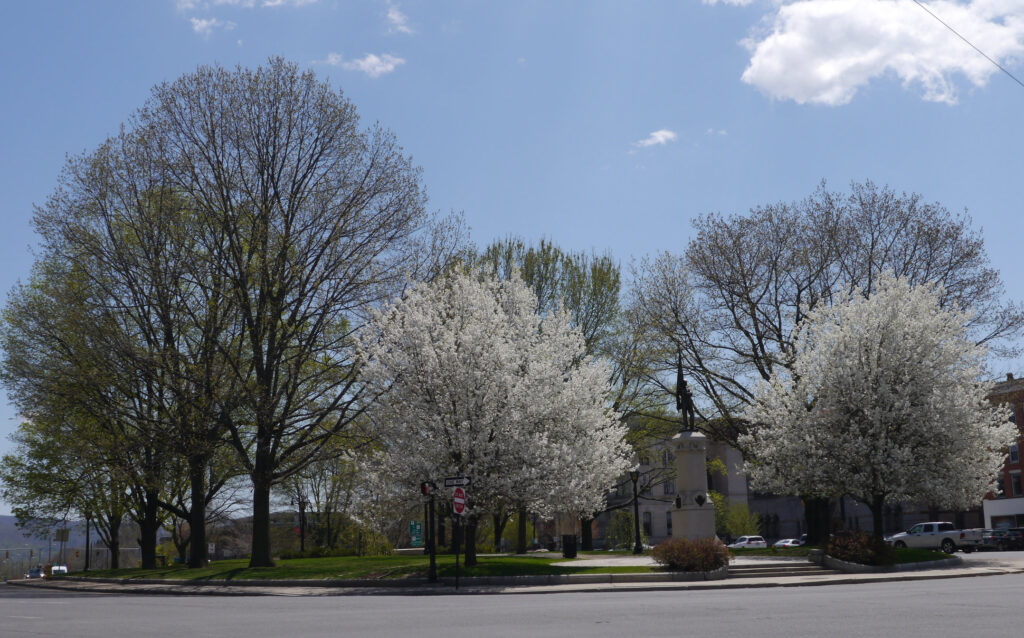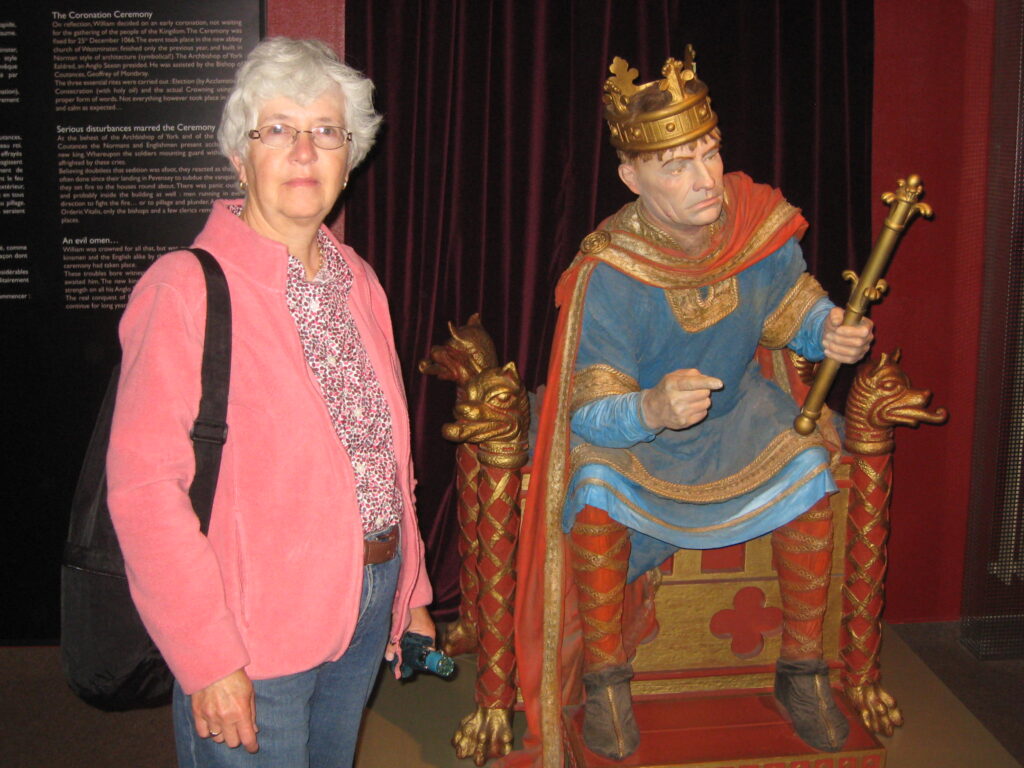This is the seventh in a series of posts about four generations of my ancestors in colonial Massachusetts and Connecticut. It includes the Bagg, Burt, Phelps, Moseley, Stanley and other related families between 1635 and 1795.

David Bagg was a pioneering settler in the remote Berkshire hills of western Massachusetts, he married three times and brought up eight children. At age 60, he fought beside his adult sons in the American Revolution. He was my five-times great-grandfather, and I think of him as a survivor.
Born in Feb. 1716/1717, David was the youngest of the ten surviving children of Daniel Bagg and Hannah Phelps of Westfield, Massachusetts.1Westfield was a thriving town in the Connecticut River valley at the time, and David’s father, a farmer and merchant, was a fairly prominent citizen. David had eight older sisters, and his one brother was 20 years older than him.
In 1738, when David was 21, his father died. In his will,2Daniel Bagg left money to each of his eight daughters and he left his farmland to his two sons, Daniel Jr. and David, to share equally. Daniel Jr., who was married, was to get the new house, while David inherited the old house, plus some cash so he could repair it. David also inherited the team of oxen that were used to plough the fields and pull the farm wagons. This bequest was probably a big help to David as he began his adult life.
A year after his father’s death, on July 7, 1739, David married Elizabeth Moseley,3 the daughter of prominent Westfield resident Consider Moseley and his wife Elizabeth Bancroft. Like most other New England couples at the time, David and Elizabeth had a large family: Elizabeth, Joseph, Rachel, Martin, Eunice, Abner, Aaron and Phineas. Phineas (my four-times great-grandfather) was probably born in 1751, however, there is no record of his baptism.
As far as I know, David led a quiet life in his younger years. He farmed the fields he had inherited from his father and, in 1754, his brother sold him the 12 tracts of land in Westfield that he had inherited.4But David’s life seems to have been turned upside down with his wife’s death in Westfield on April 11, 1759.5 At the time, his children ranged in age from about 18 to eight.
In the wake of his wife’s death, David must have decided to leave Westfield. He bought a farm in nearby Blandford Township and the following year, on June 25, 1761, he married Martha Cook, the widow of John Dickinson.6 This marriage did not last long, however, as Martha died a year later.
The Move to Pittsfield
Over the next few years, David made an even bigger move. He gradually sold off his properties in Westfield, selling the last tract of land in 1777. He also sold the farm in Blandford in 1766.7 Meanwhile, he purchased property in Pittsfield, Massachusetts, in the isolated Berkshire hills of the colony’s western frontier.
In this newly settled area, the soil was rockier and less fertile than in the Connecticut valley, but perhaps David felt that Pittsfield would offer an opportunity for a fresh start for himself and affordable land for his five sons. The move was also typical of a trend in colonial New England for farmers and their growing families to leave settled areas, which were becoming crowded, and found new towns. David’s father Daniel had done the same thing as a young man, moving from Springfield, MA, where he was born, to Westfield, which at that time had been the colony’s westernmost outpost.
The Pittsfield site was purchased in 1734 by an investor from Boston, but efforts to clear the land immediately were abandoned because of the threat of Indian raids. The first settlers, many of whom came from Westfield, arrived in 1752.
David bought property in Pittsfield in 17608 and probably moved there with his family not long after 1764.9 The move wouldn’t have been easy: the road to Pittsfield was an old aboriginal trail that had been widened, but was often impassable. David and his family must have moved their most important furniture and implements, cleared the land and built a log house. In 1772, David Bagg and a household of eight were listed among the 666 residents of Pittsfield.10
In 1769, David married a third time.11 His new wife was Ruth (Owen) Tupper, the widow of Thomas Tupper of Salisbury, Connecticut. She gave birth to 13 children during her first marriage, five of whom are recorded as living to adulthood.
David’s lifetime was a period of social and political change. For one thing, the people of New England were not as religious as their great-grandparents had been when they came to North America as Puritans fleeing religious persecution.
Politically, the Seven Years’ War (also known as the French and Indian War,) ended in 1763 with the French ceding New France to the British. This brought to an end the raids on Massachusetts towns by the aboriginal allies of the French. It also led indirectly to the American Revolution: the war had left the British heavily in debt, and the high taxes they imposed on the Thirteen Colonies eventually led to a revolt.
Many people in the Berkshires were strongly opposed to the British, and David must have agreed. During the American Revolution, David served in Pittsfield militia regiments on two occasions: in January 1776, he marched to Albany for five days, and in July, 1777, he served for 10 days on a march to Manchester. Each time, one of his sons (Phineas or Martin) accompanied him.12
The last mention of David Bagg of Pittsfield in the records of Massachusetts is a suit on a note given to him by John Phelps, with court action in June, 1784.13
In the 1790 federal census, sons Martin and Phineas Bagg and Daniel Bagg (likely a nephew) were counted in Pittsfield, while son Joseph appeared in nearby Lanesborough.14 David might have been living with one of his children, but he was probably deceased by then.
See also:
Janice Hamilton, “Daniel Bagg’s Will,” Writing Up the Ancestors, June 13, 2018, https://www.writinguptheancestors.ca/2018/06/daniel-baggs-will.html
Janice Hamilton, “Considering Consider Moseley,” Writing Up the Ancestors, May 16, 2018, https://www.writinguptheancestors.ca/2018/05/considering-consider-moseley.html
Janice Hamilton, “John Bagg of Springfield, Massachusetts,” Writing Up the Ancestors, Feb. 22, 2018, https://www.writinguptheancestors.ca/2018/02/john-bagg-of-springfield-massachusetts.html
Janice Hamilton, “An Economic Emigrant,” Writing Up the Ancestors, Oct. 16, 2013, https://www.writinguptheancestors.ca/2013/10/an-economic-emigrant.html
Janice Hamilton, “Who Was Phineas Bagg?” Writing Up the Ancestors, Oct. 11, 2014, https://www.writinguptheancestors.ca/2014/10/who-was-phineas-bagg.html
Notes:
There were several men named David Bagg in this time period. David Bagg jr.,son of David and Hannah of Springfield died in 1756 in his 19th year. David Bagg, son of Jonathon Bagg of Springfield, died in 1760 in his 50th year. Also David Bagg, born Westfield to Mary Sackett, March 27, 1739.
The children of David and Elizabeth (Moseley) Bagg.
(The records are spotty, and some of these details may be incorrect or incomplete. All sources from either Americanancestors.org or Familysearch.org)
Elizabeth bapt. Nov. 1, 1741 at Westfield (Westfield, MA, Baptisms performed at the Church of Christ, 1679-1836), Elizabeth Bagg of Blandford m. Hezekiah Jones of Pittsfield, July 12, 1764, Westfield (Massachusetts Vital Records, 1620-1850, Westfield, vol. 2).
Joseph born Jan 6, 1739/40 at Westfield, bapt. Nov. 1, 1741; (Massachusetts Vital Records, 1620-1850, Westfield, vol. 1) soldier in American Revolution, m. Eunice Loomis in Blandford, Dec. 29, 1765, (Massachusetts Town Clerk, Vital and Town Records), lived in Lanesborough, d. 1836.
Rachel bapt Dec 19 1742 at Westfield, (Westfield, MA, Baptisms performed at the Church of Christ, 1679-1836)
Martin bapt Jan 27, 1745 at Westfield (Westfield, MA, Baptisms performed at the Church of Christ, 1679-1836); soldier in American Revolution; m. Olive Goodrich, 1792 at Pittsfield Eunice bapt June 8, 1746 at Westfield (Westfield, MA, Baptisms performed at the Church of Christ, 1679-1836), m. Adam Noble, 22 May 1769, Pittsfield (Massachusetts Marriages, 1695-1910)
Abner bapt May 15, 1748 at Westfield (Westfield, MA, Baptisms performed at the Church of Christ, 1679-1836), d. 8 Feb. 1773, Pittsfield (Massachusetts Deaths and Burials, Familysearch.org)
Aaron bapt Mar 11, 1750 at Westfield (Westfield, MA, Baptisms performed at the Church of Christ, 1679-1836), soldier in American Revolution
Phineas born c. 1751 in Pittsfield, MA; yeoman in Pittsfield 1777, soldier in American Revolution; moved to Laprairie, QC c. 1795; d. 31 Nov. 1823, in Montreal. m. 1) Pamela Stanley of Litchfield, Conn, 21 Mar. 1780 in Pittsfield; d. c. 1793; 2) (common law) Ruth Langworthy.
Footnotes:
- Massachusetts: Vital Records, 1621-1850 (Online Database: AmericanAncestors.org, New England Historic Genealogical Society, 2001-2016). https://www.americanancestors.org/DB190/i/13250/3/253010247
- Hampshire County, MA: Probate File Papers, 1660-1889. Online database. AmericanAncestors.org. New England Historic Genealogical Society, 2016, 2017. (From records supplied by the Massachusetts Supreme Judicial Court Archives and the Hampshire County Court. Digitized images provided by FamilySearch.org) https://www.americanancestors.org/DB1653/i/33925/7-17-co3/0
- Massachusetts: Vital Records, 1621-1850 (Online Database: AmericanAncestors.org, New England Historic Genealogical Society, 2001-2016).https://www.americanancestors.org/DB190/i/13251/4/253014174
- William A. Cooper, “The James Bagg Family of Lanesborough, Mass,” unpublished, 1918.
- Massachusetts: Vital Records, 1621-1850 (Online Database: AmericanAncestors.org, New England Historic Genealogical Society, 2001-2016). https://www.americanancestors.org/DB190/i/13250/91/253013581
- Massachusetts: Vital Records, 1621-1850 (Online Database: AmericanAncestors.org, New England Historic Genealogical Society, 2001-2016). https://www.americanancestors.org/DB190/i/14507/117/264964546
- Cooper, ibid.
- Rollin H. Cooke, Pittsfield Families, Vol. 1 A-B, p. 73.
- J.E.A. Smith, The History of Pittsfield, (Berkshire County,) Massachusetts, From the Year 1734 to the Year 1800. Boston: Lee and Shepard, 1869. p. 476.
- “The Number of Families and Persons in the town of Pittsfield, Nov. 16, 1772” Berkshire Genealogist,fall 1993, vol. 14, no 4, p. 111.
- Vital Records from The NEHGS Register. Online database. AmericanAncestors.org. New England Historic Genealogical Society, 2014. (Compiled from articles originally published in The New England Historical and Genealogical Register.) https://www.americanancestors.org/DB522/r/264680608
- Massachusetts Soldiers and Sailors in the War of the Revolution, Ancestry.com
- Cooper, ibid.
- Ancestry.com. 1790 United States Federal Census [database on-line]. Provo, UT, USA: Ancestry.com Operations, Inc., 2010. Images reproduced by FamilySearch. Original data: First Census of the United States, 1790 (NARA microfilm publication M637, 12 rolls). Records of the Bureau of the Census, Record Group 29. National Archives, Washington, D.C.
Year: 1790; Census Place: Pittsfield, Berkshire, Massachusetts; Series: M637; Roll: 4; Page: 483; Image: 526; Family History Library Film: 0568144. (accessed Jan. 14, 2013)

